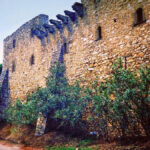Episkopi (Episcope) of Skopelos
Skopelos Church Episkopi, Skopelos Diocese, Skopelos Bishopric, Skopelos church Episcope, Episkopi of Skopelos, Skopelos churches, Skopelos Monastery Episkopi, Skopelos Monastery Episcope, Skopelos Sightseeings, Skopelos Religion, Skopelos culture, Skopelos Island, Northern Sporades, Greece
Episkopi (Episcope) of Skopelos
The Episkopi of Skopelos Island, situated 2 kilometers south of Skopelos town, is a remarkable Venetian edifice. The current Diocese is designed in the Venetian architectural style as a house. At its heart is a small single-aisled church dating back to the 16th and 17th centuries, constructed atop the remains of a larger three-aisled basilica from the mid-Byzantine period.
Under the present church of the Bishopric, an old church of the 11th century (1078 AD), was discovered in 1955. Its foundations extend to the south and west of the present church. This earlier church was constructed on the site of an early Christian place of worship that was established over an ancient temple.
The basilica was built by Anastassios, the city’s bishop, in the location of a prior one, as suggested by a marble inscription, and it was officially opened in the year 1078.
The current church is encircled by an impressive stone courtyard, which also incorporates the wall of a grand structure, potentially the front of a bishop’s palace. Nevertheless, this construction was left incomplete due to a pirate assault orchestrated by the Ottoman corsair Hayreddin Barbarossa in 1538.
The wall is equipped with dual rows of windows and a multitude of openings intended for defensive functions. At the focal point of the upper level, there are the stone corbels (columns) of the balcony, embellished with intricately carved animal figures.
The Dimitriades brothers acquired the site, in 1949, and conducted excavation work. The supervisor was the Professor A. Xyggopoulos. These excavations unearthed numerous ancient artifacts, which are now on display throughout the diocese area.
The church’s feast day is celebrated on the 23rd of August. On the eve of the diocese’s feast day, a solemn all-night vigil ceremony is meticulously observed, followed by the festivities the next day.

